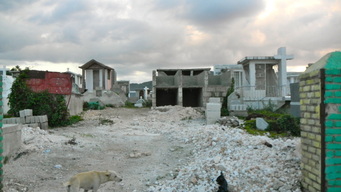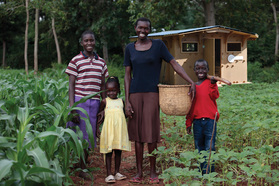
Disaster Shelter | Haiti Economic Conditions, Part 2 of 5
What can be done about deforestation in Haiti?
Haiti is suffering from a vicious cycle where poverty and overpopulation fuels the denuding of more and more ground. This cycle results in more ground being washed away which circles back to the beginning of the cycle. In general terms, Haiti needs better control of the rainfall they do receive. This means water projects, erosion control, dams and reservoirs, and irrigation, but all these projects are expensive and require lots of concrete and labor. Here’s the real problem standing in the way of progress… Haiti imports all their concrete (cement powder). There is always a ship anchored in the bay and lighters (smaller boats) ferrying the cement to shore where it is broken into individual shipments, loaded onto trucks and delivered throughout the country. All of this activity is expensive and made more so by the fact that it is all one-way traffic. The trucks return (mostly) empty, the lighters return empty and the ship returns empty. All this is a real drag on the economy and it upsets the balance of payments because the country has few exports to offset the money drain from importing cement.
What can be done about deforestation in Haiti?
Haiti is suffering from a vicious cycle where poverty and overpopulation fuels the denuding of more and more ground. This cycle results in more ground being washed away which circles back to the beginning of the cycle. In general terms, Haiti needs better control of the rainfall they do receive. This means water projects, erosion control, dams and reservoirs, and irrigation, but all these projects are expensive and require lots of concrete and labor. Here’s the real problem standing in the way of progress… Haiti imports all their concrete (cement powder). There is always a ship anchored in the bay and lighters (smaller boats) ferrying the cement to shore where it is broken into individual shipments, loaded onto trucks and delivered throughout the country. All of this activity is expensive and made more so by the fact that it is all one-way traffic. The trucks return (mostly) empty, the lighters return empty and the ship returns empty. All this is a real drag on the economy and it upsets the balance of payments because the country has few exports to offset the money drain from importing cement.

Cement is an indispensable commodity in Haiti. It would be hard to overstate that cement tends to come just after water and food in its importance to the economy and its reach into the daily lives of the people. Because they have no forests and imported wood is costly, everything in Haiti is built with cement.
The way it seems to work is this. If a family has a good week, they can afford the next bag or two of cement. Everywhere you go in Haiti you’ll see piles of limestone gravel next to piles of limestone sand. The cement is normally mixed on the ground with this sand and gravel to make concrete, poured into cinder block molds or poured into forms to build housing. Because every bag is precious and the need is far greater than the supply, all building materials are stretched to the limit and invariably, too much is attempted with too little, resulting in weak construction… which, by the way, fell down in the earthquake, killing hundreds of thousands. It sometimes takes years to build the family home, one bag of cement at a time and this piecemeal construction with its multiple concrete pours, also results in poor quality. We all know that time is money. Taking years to build a house costs far more than it should because time has many costs associated with it. The important thing to understand from all this is; the high cost of imported cement is a major drag on the economy of Haiti, and the resulting poor quality construction was the major cause of the many, many earthquake deaths.
The way it seems to work is this. If a family has a good week, they can afford the next bag or two of cement. Everywhere you go in Haiti you’ll see piles of limestone gravel next to piles of limestone sand. The cement is normally mixed on the ground with this sand and gravel to make concrete, poured into cinder block molds or poured into forms to build housing. Because every bag is precious and the need is far greater than the supply, all building materials are stretched to the limit and invariably, too much is attempted with too little, resulting in weak construction… which, by the way, fell down in the earthquake, killing hundreds of thousands. It sometimes takes years to build the family home, one bag of cement at a time and this piecemeal construction with its multiple concrete pours, also results in poor quality. We all know that time is money. Taking years to build a house costs far more than it should because time has many costs associated with it. The important thing to understand from all this is; the high cost of imported cement is a major drag on the economy of Haiti, and the resulting poor quality construction was the major cause of the many, many earthquake deaths.

The interesting thing is, cement is simply cooked, limestone powder. The whole Island of Hispaniola is made of limestone…it’s literally everywhere, underfoot. So you might ask, why doesn’t Haiti produce their own cement? The answer in a word is… energy. It takes energy to cook limestone powder at almost 900 degrees C to make cement, and Haiti doesn’t have any available. All their oil is imported and there is no local, natural gas industry. The result is that it’s still cheaper to import cement made where fuel is cheap than to import fuel and make cement even if the raw material, limestone, is practically free.
What they do have in Haiti is limestone, inexpensive labor and sunshine, lots of sunshine. Putting these ideas together we come to the really important question, is it possible to cook limestone with solar power?
The exciting answer is…YES. I’ll tell you how in Part 3 (coming soon!).
READ: Part 1.
READERS: What are some suggestions you might offer?
What they do have in Haiti is limestone, inexpensive labor and sunshine, lots of sunshine. Putting these ideas together we come to the really important question, is it possible to cook limestone with solar power?
The exciting answer is…YES. I’ll tell you how in Part 3 (coming soon!).
READ: Part 1.
READERS: What are some suggestions you might offer?

About Shelter In A Day | Disaster Shelters
Winner of 2013 Aid and International Development Forum (AIDF) "Most Innovative Product Award." Shelter In A Day is the brainchild of eco-friendly, furniture designer Frank Schooley. Shelter's disaster recovery housing provides safe and secure, simple to construct, green homes for those displaced by natural disasters, such as hurricanes, earthquakes or floods.
The disaster shelters are a solidly constructed, termite, rust and rot resistant house, with lockable doors and windows. Homes are crafted from waterproof, recycled wood fiber material and can be easily erected anywhere, in one day.
Winner of 2013 Aid and International Development Forum (AIDF) "Most Innovative Product Award." Shelter In A Day is the brainchild of eco-friendly, furniture designer Frank Schooley. Shelter's disaster recovery housing provides safe and secure, simple to construct, green homes for those displaced by natural disasters, such as hurricanes, earthquakes or floods.
The disaster shelters are a solidly constructed, termite, rust and rot resistant house, with lockable doors and windows. Homes are crafted from waterproof, recycled wood fiber material and can be easily erected anywhere, in one day.
| | |
